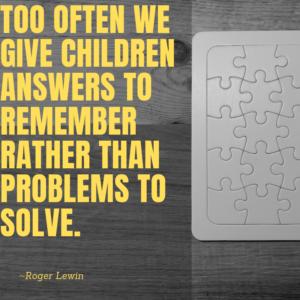As a mother, making sure my daughter is prepared for life is the number one item that requires work on a daily basis. Whether I am working on it personally or sharing this task with the staff of an Early Education Center, there are skills that need to be learned by every child that will ensure success for them in the future. If you are a parent, perhaps you have seen the most recent hot topic in this area is a discussion on student problem-solving.
Roger Lewin said, “Too often we give children answers to remember rather than problems to solve.” and in recent years the education debate against  schools and teachers is that far too often “training” on taking tests is outweighing the “educational skills” our children need to learn. So I began asking What ARE the educational skills my child should be learning? and also What is the most important skill I can help to teach her? With these two questions in mind and my own background in early education, I started tracking some of the common subjects I was seeing in parenting and educational articles. What I found was a discussion happening around the importance of, and how to teach, problem-solving to children.
schools and teachers is that far too often “training” on taking tests is outweighing the “educational skills” our children need to learn. So I began asking What ARE the educational skills my child should be learning? and also What is the most important skill I can help to teach her? With these two questions in mind and my own background in early education, I started tracking some of the common subjects I was seeing in parenting and educational articles. What I found was a discussion happening around the importance of, and how to teach, problem-solving to children.
How many of us remember reading or hearing Aesop’s Fable The Crow and the Pitcher? I remember as a child hearing Aesop’s fables frequently as they were very short and always contained a lesson. In this particular fable, Aesop writes about a thirsty crow who comes upon a pitcher with some water in the bottom. After many unsuccessful attempts to push his beak far enough into the pitcher to reach the water, the bird is ready to give up, that is until he notices small pebbles in the area. Trying out a new method, the crow begins dropping pebbles in the pitcher until the water level is high enough for his beak to reach and quench his thirst.
This fable shows that problem-solving occurs any time we are faced with a problem… or does it? I was gathering information that discussed the lack of this skill, however, my daughter seemed to come upon problems daily that she continually asked my help with. What would cause us to argue that children no longer have problem-solving skills? I must admit as I became more observant of my interactions I came to notice a few flaws in how I addressed her problem-solving opportunities.
- First, in order to save time, I was doing things for her rather than allowing her to problem solve the situation. For example, getting our shoes on in order to leave the house. Rather than allowing my daughter to problem solve a way to keep the tongue of her shoe from falling back down before putting her foot completely in the shoe, I would take the shoe and do this for her. I was robbing her of the opportunity to problem solve, but also the opportunity to learn the foundational self-help skills. I would not always be there to put her shoes on, nor would I always want to put her shoes on for her.
- I also noticed when interacting with friends at the park, when a disagreement came up between the children that I (and other parents) stepped in to “fix” things instead of helping the children work through it. I know this isn’t something all ages can do and don’t recommend ignoring issues either.
- And then there is technology. Was I as a parent allowing technology to hinder the problem-solving skills of my daughter rather than supporting them? By allowing the first answer found to a problem be the only answer we talked about?
I wondered if this was what teachers in the public schools were facing. Are we so strapped on time during the day that we only allow a limited time for problem-solving exploration before we just gave the answer? How were teachers teaching problem-solving anyway? The University of Waterloo shares some steps that teachers can use here. And while this information can be used for older children, I decided to try the following with my young daughter.
- Make the time. It may take longer than if I did it myself, but allowing the time to work through the process is more important than the answer sometimes.
- Talk. I want my daughter to be able to communicate, not only what the problem is but what her thoughts are to fix it. If you take the time to talk it out your child learns that they and the problem are important and become more motivated to try.
- Try. It might get messy and it probably won’t work out the first time, but trying the possible solutions your child learns confidence. It is also a great way to learn that all failures aren’t bad but learning opportunities.
What will you problem solve next?
This article previously published by Jessica Littleton on LinkedIn and used with permission.